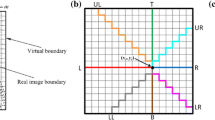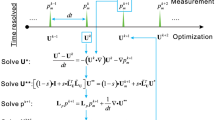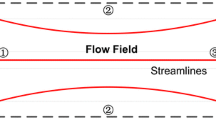Abstract
The performance of four pressure estimation techniques using Eulerian material acceleration estimates from planar, two-component Particle Image Velocimetry (PIV) data were evaluated in a bluff body wake. To allow for the ground truth comparison of the pressure estimates, direct numerical simulations of flow over a circular cylinder were used to obtain synthetic velocity fields. Direct numerical simulations were performed for \(Re_\mathrm{D} = 100\), 300, and 1575, spanning laminar, transitional, and turbulent wake regimes, respectively. A parametric study encompassing a range of temporal and spatial resolutions was performed for each \(Re_\mathrm{D}\). The effect of random noise typical of experimental velocity measurements was also evaluated. The results identified optimal temporal and spatial resolutions that minimize the propagation of random and truncation errors to the pressure field estimates. A model derived from linear error propagation through the material acceleration central difference estimators was developed to predict these optima, and showed good agreement with the results from common pressure estimation techniques. The results of the model are also shown to provide acceptable first-order approximations for sampling parameters that reduce error propagation when Lagrangian estimations of material acceleration are employed. For pressure integration based on planar PIV, the effect of flow three-dimensionality was also quantified, and shown to be most pronounced at higher Reynolds numbers downstream of the vortex formation region, where dominant vortices undergo substantial three-dimensional deformations. The results of the present study provide a priori recommendations for the use of pressure estimation techniques from experimental PIV measurements in vortex dominated laminar and turbulent wake flows.













Similar content being viewed by others
References
Auteri F, Carini M, Zagaglia D, Montagnani D, Gibertini G, Merz CB, Zanotti A (2015) A novel approach for reconstructing pressure from PIV velocity measurements. Exp Fluids 56:45
Azijli I, Dwight R (2015) Solenoidal filtering of volumetric velocity measurements using Gaussian process regression. Exp Fluids 56:198
Azijli I, Sciacchitano A, Ragni D, Palha A, Dwight R (2016) A posteriori uncertainty quantification of PIV-based pressure data. Exp Fluids 57:72
Baur T, Köngeter J (1999) Piv with high temporal resolution for the determination of local pressure reductions from coherent turbulent phenomena. In: 3rd Int. Workshop on particle image velocimetry, Santa Barbara, pp 101–106
Blinde P, Michaelis D, van Oudheusden B, Weiss P, de Kat R, Laskari A, Jeon Y, David L, Schanz D, Huhn F, Gesemann S, Novara M, McPhaden C, Neeteson N, Rival D, Schneiders J, Schrijer F (2016) Comparative assessment of piv-based pressure evaluation techniques applied to a transonic base flow. In: 18th International symposium on the application of laser and imaging techniques to fluid mechanics, Lisbon, Portugal
Bloor M (1964) The transition to turbulence in the wake of a circular cylinder. J Fluid Mech 19:290–304
Charonko J, King C, Smith B, Vlachos P (2010) Assessment of pressure field calculations from particle image velocimetry measurements. Meas Sci Technol 21:105401
Dabiri J, Bose S, Gemmell B, Colin S, Costello J (2014) An algorithm to estimate unsteady and quasi-steady pressure fields from velocity field measurements. J Exp Biol 217:331–336
de Kat R, Ganapathisubramani B (2013) Pressure from particle image velocimetry for convective flows: a Taylors hypothesis approach. Meas Sci Technol 24:024002
de Kat R, van Oudheusden B (2012) Instantaneous planar pressure determination from PIV in turbulent flow. Exp Fluids 52:1089–1106
Elsinga G, Scarano F, van Oudheusden B (2006) Tomographic particle image velocimetry. Exp Fluids 41:933–947
Etebari A, Vlachos P (2005) Improvements on the accuracy of derivative estimation from DPIV velocity measurements. Exp Fluids 39:1040–1050
Fujisawa N, Tanahashi S, Srinivas K (2005) Evaluation of pressure field and fluid forces on a circular cylinder with and without rotational oscillation using velocity data from PIV measurement. Meas Sci Technol 16:989–996
Ghaemi S, Ragni D, Scarano F (2012) PIV-based pressure fluctuations in the turbulent boundary layer. Exp Fluids 53:1823–1840
Gurka R, Liberzon A, Hefetz D, Rubinstein D, Shavit U (1999) Computation of pressure distribution using PIV velocity data. In: 3rd Int. workshop on particle image velocimetry, Santa Barbara, pp 671–676
Hosokawa S, Moriyama S, Tomiyama A, Takada N (2003) PIV measurement of pressure distributions about single bubbles. J Nucl Sci Technol 40(10):754–762
Huhn F, Schanz D, Gesemann S, Schröder A (2016) FFT integration of instantaneous 3D pressure gradient fields measured by Lagrangian particle tracking in turbulent flows. Exp Fluids 57:151
Inoue O, Sakuragi A (2008) Vortex shedding from a circular cylinder of finite length at low Reynolds numbers. Phys Fluids 20:033601
Jakobsen M, Dewhirst T, Greated C (1997) Particle image velocimetry for predictions of acceleration fields and forces within fluid flows. Meas Sci Technol 8:1502–1516
Jaw S, Chen J, Wu P (2009) Measurement of pressure distribution from PIV experiments. J Vis 12:27–35
Jeong J, Hussain F (1995) On the identification of a vortex. J Fluid Mech 285:69
Laskari A, de Kat R, Ganapathisubramani B (2016) Full-field pressure from snapshot and time-resolved volumetric PIV. Exp Fluids 57:44
Liu X, Katz J (2006) Instantaneous pressure and material acceleration measurements using a four-exposure PIV system. Exp Fluids 41:227–240
Lynch K, Scarano F (2014) Material acceleration estimation by four-pulse tomo-PIV. Meas Sci Technol 25:084005
Marzouk O, Nayfeh A, Akhtar I, Arafat H (2007) Modeling steady-state and transient forces on a cylinder. J Vib Control 13(7):1065–1091
McClure J, Morton C, Yarusevych S (2015) Flow development and structural loading on dual step cylinders in laminar shedding regime. Phys Fluids 92:455–470
McClure J, Yarusevych S (2016) Vortex shedding and structural loading characteristics of finned cylinders. J Fluids Struct 10:100–101
Moin P, Mahesh K (1998) Direct numerical simulation: a tool in turbulence research. Annu Rev Fluid Mech 30:539–578
Morton C, Yarusevych S (2010) Vortex shedding in the wake of a step cylinder. Phys Fluids 22:083602
Murai Y, Nakada T, Suzuki T, Yamamoto F (2007) Particle tracking velocimetry applied to estimate the pressure field around a Savonius turbine. Meas Sci Technol 18:2491–2503
Neeteson N, Rival R (2015) Pressure-field extraction on unstructured flow data using a Voronoi tessellation-based networking algorithm: a proof-of-principle study. Exp Fluids 56:44
Norberg C (2003) Fluctuating lift on a circular cylinder: review and new measurements. J Fluids Struct 17:57–96
Novara M, Scarano F (2013) A particle-tracking approach for accurate material derivative measurements with tomographic PIV. Exp Fluids 54:1584
Pan Z, Whitehead J, Thompson S, Truscott T (2016) Error propagation dynamics of PIV-based pressure field calculations: how well does the pressure Poisson solver perform inherently?’. arXiv:1602.00037 [physics.flu-dyn]
Persillon H, Braza M (1998) Physical analysis of the transition to turbulence in the wake of a circular cylinder by three-dimensional NavierStokes simulation. J Fluid Mech 365:23–88
Pröbsting S, Scarano F, Bernardini M, Pirozzoli S (2013) On the estimation of wall pressure coherence using time-resolved tomographic PIV. Exp Fluids 54:1567
Ragni D, van Oudheusden BW, Scarano F (2012) 3D pressure imaging of an aircraft propeller blade-tip flow by phase-locked stereoscopic PIV. Exp Fluids 52:463–477
Regert T, Chatellier L, Tremblais B, David L (2001) Determination of pressure fields from time-resolved data. In: 9th International symposium on particle image velocimetry. Tsukuba, Japan
Roshko A (1993) Perspectives of bluff body aerodynamics. J Wind Ind Aerodyn 49:79–100
Scarano F, Poelma C (2009) Three-dimensional vorticity patterns of cylinder wakes. Exp Fluids 47(1):69–83
Schanz D, Gesemann S, Schröder A (2016) Shake-The-Box: Lagrangian particle tracking at high particle image densities. Exp Fluids 57:70
Schneiders J, Pröbsting S, Dwight R, van Oudheusden B, Scarano F (2016) Pressure estimation from single-snapshot tomographic PIV in a turbulent boundary layer. Exp Fluids 57:53
Sciacchitano A, Wieneke B (2016) PIV uncertainty propagation. Meas Sci Technol 27:084006
Trefethen L (2000) Spectral methods in Matlab. SIAM, Philadelphia
Tronchin T, David L, Farcy A (2015) Loads and pressure evaluation of the flow around a flapping wing from instantaneous 3D velocity measurements. Exp Fluids 56:1870
van Oudheusden B (2013) PIV-based pressure measurement. Meas Sci Technol 24:032001
van Oudheusden B, Scarano F, Casimiri E (2006) Non-intrusive load characterization of an airfoil using PIV. Exp Fluids 40:988–992
van Oudheusden B, Scarano F, Roosenboom E, Casimiri E, Souverein L (2007) Evaluation of integral forces and pressure fields from planar velocimetry data for incompressible and compressible flows. Exp Fluids 43:153–162
Violato D, Moore P, Scarano F (2011) Lagrangian and Eulerian pressure field evaluation of rod-airfoil flow from time-resolved tomographic PIV. Exp Fluids 50:1057–1070
Wieselsberger C (1921) New data on the law of hydro and aerodynamic resistance. Phys Z 22:321–328
Williamson C (1989) Oblique and parallel modes of vortex shedding in the wake of a circular cylinder at low Reynolds numbers. J Fluid Mech 206:579
Williamson C (1996) Vortex dynamics in the cylinder wake. Annu Rev Fluid Mech 28:477–539
Wissink J, Rodi W (2008) Numerical study of the near wake of a circular cylinder. Int J Heat Fluid Flow 29:1060–1070
Zhao M, Cheng L (2014) Vortex-induced vibration of a circular cylinder of finite length. Phys Fluids 26:015111
Acknowledgements
The authors gratefully acknowledge the contribution of the Natural Science and Engineering Research Council (NSERC) to the funding of this research.
Author information
Authors and Affiliations
Corresponding author
Rights and permissions
About this article
Cite this article
McClure, J., Yarusevych, S. Optimization of planar PIV-based pressure estimates in laminar and turbulent wakes. Exp Fluids 58, 62 (2017). https://doi.org/10.1007/s00348-017-2337-7
Received:
Revised:
Accepted:
Published:
DOI: https://doi.org/10.1007/s00348-017-2337-7




